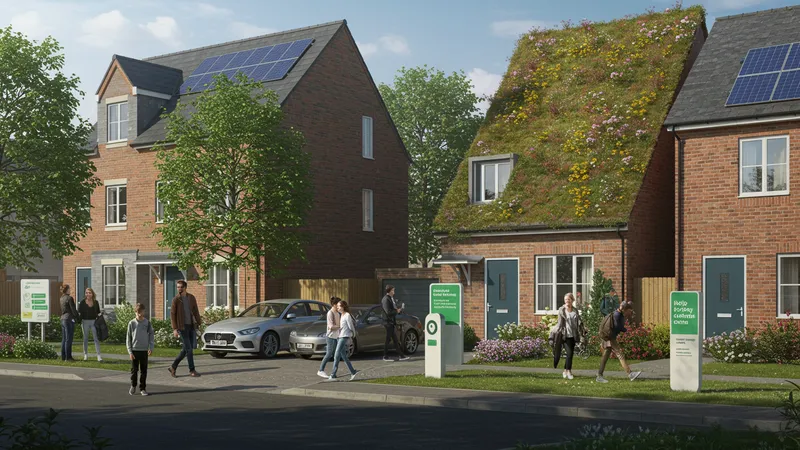

The concept of exploring real estate and housing market trends in the United Kingdom involves examining the evolving factors shaping property values, ownership patterns, and the overall demand for homes across the nation. This deep dive considers changing buyer preferences, shifts in rental markets, and the impact of economic, social, and policy forces on where and how people choose to live. Market trends reveal not only where property “hotspots” may emerge but also track affordability, sustainability initiatives, and the reimagining of urban and rural spaces in response to societal needs.
Understanding the UK's real estate landscape requires close attention to indicators such as price fluctuations, new construction activity, government regulations, and technology adoption within the sector. Stakeholders—including buyers, renters, landlords, developers, and policymakers—rely on these insights to adapt strategies, make informed decisions, and predict long-term market behavior.

In 2024, digital platforms like Rightmove and Zoopla dominate both the buying and renting experience, making property searching more accessible and data-driven than ever before. These portals collect and present granular information, helping users assess the value and growth of different neighbourhoods. Their reach has transformed the way people approach house-hunting in the United Kingdom.
The UK House Price Index, published by government authorities, functions as a benchmark for market observers, allowing comparisons over time and between different regions such as London, the North West, or Scotland. It also reflects broader economic realities, such as interest rates, legislative changes, and global investment influences, providing essential data for both business and private decision-makers.
Regional disparities remain a key feature of UK housing market trends. For example, London’s property values continue to surpass most areas of the country, though other locations like Manchester, Birmingham, and Bristol show rising demand and noteworthy investment activity. The increasing focus on sustainability and green initiatives is further shaping development and renovation projects throughout the nation.
Amid ongoing shifts—such as hybrid working patterns and changing household compositions—the flexibility and adaptability showcased by the UK’s real estate portals empower individuals to make more personalized choices. Technology increasingly bridges the gap between buyers, sellers, and renters, while governmental indices offer reliable context for major decisions involving personal or portfolio investments.
Ultimately, these leading tools and sources lay the groundwork for understanding where the UK housing market is headed. The deeper details reveal even more valuable insights ahead, especially when considering affordability, urbanization, and government policy effects.
Digitalisation is fundamentally reshaping property transactions across the United Kingdom. Platforms like Rightmove and Zoopla provide instant access to property listings, detailed photographs, virtual tours, and pricing trends. This ease of information empowers buyers and renters to make quicker, more informed choices, while sellers and landlords are reaching a more expansive audience than traditional local adverts ever achieved.

The user experience on these platforms is tailored for transparency. Real-time data, filtering tools for budget and preferences, and automated alerts mean property seekers don’t miss emerging prospects. For landlords and agents, this means efficiently managing listings and responding to potential renters or buyers faster, often leading to reduced vacancy rates.
In densely populated cities like London and Edinburgh, digital platforms have made competitive markets slightly more accessible. They enable users to compare properties not just on price, but also on long-term trends such as rental yields and postcode desirability. These insights have prompted greater scrutiny—and smarter decision-making—across all levels of the market.
Accessibility via smartphones and tablets further widens audience engagement. According to industry estimates, more than 90% of prospective UK buyers and renters now begin their search online, reflecting a profound digital shift that has made platforms like Rightmove and Zoopla indispensable in today’s housing market.
The UK House Price Index is a vital source of authoritative, unbiased data on residential property value changes across the United Kingdom. It records monthly fluctuations in average sold prices, regional differences, and the pace of growth or decline, offering key visibility for everyone from homeowners to investors and policymakers.

This government-produced index enables users to spot macro trends, such as how housing prices in the South East compare to those in Wales or Northern Ireland. The data is widely cited in media, research, and professional forecasts, providing a foundation for discussions on housing affordability, inflation, and future supply needs.
With its free public access, the UK House Price Index democratizes information that was once mainly the domain of estate agents and financial analysts. Prospective buyers, for instance, can track whether their target area’s prices are on an upward or downward curve before committing to a purchase.
Importantly, the index is also used as an input when governments debate policy changes—such as adjusting stamp duty or incentivizing first-time buyers—which ripple across the market. Having clear data supports intelligent planning for both private and public stakeholders, reducing uncertainty in a sector where minor shifts can have notably widespread effects.
While national averages offer useful context, regional differences in the UK’s real estate market are often dramatic. London typically commands premium prices, yet recent years have seen phenomenal surges in cities like Liverpool, Manchester, and Leeds, driven by urban regeneration projects and evolving business hubs.

Scotland’s major cities—like Glasgow and Edinburgh—have registered steady price rises, with a growing focus on eco-friendly developments and suburban expansion. In contrast, rural areas and smaller towns in Wales or the South West may benefit from remote working trends, inviting fresh demand from buyers seeking more space at comparatively lower price points.
Factors behind these trends often include infrastructure investments, university growth, and local economic shifts. The influx of young professionals and students into certain regions can quickly change demand profiles, while limited new housing supply puts upward pressure on property values in in-demand locations.
Identifying the next growth area has become more feasible with analytical tools provided by Rightmove, Zoopla, and government indices. Assessing trends in transaction volume alongside price data paints a more nuanced picture of the ongoing regional evolution in the UK housing market.
Affordability remains one of the most scrutinized aspects of the UK housing landscape. Rising property prices in many regions are challenging for first-time buyers and younger households, spurring public debate about government policies such as Help to Buy or shared ownership schemes.

Sustainability is another increasingly central trend. Developers and homeowners alike are embracing energy-efficient technologies, green retrofits, and low-impact materials. Platforms like Zoopla now even spotlight a property’s eco-features—meeting growing demand among environmentally conscious buyers.
In recent years, UK policies have influenced supply, demand, and project types. Planning reforms, incentives for brownfield development, and investments in green infrastructure are gradually shaping what—and where—new homes are built, with success tracked via official indices and market portals.
Looking to the future, the interaction between affordability measures, sustainability initiatives, and digital access will continue to determine the pace and direction of real estate trends. Stakeholders equipped with reliable, current data from portals and government sources will remain best positioned to adapt to these dynamic UK market realities.